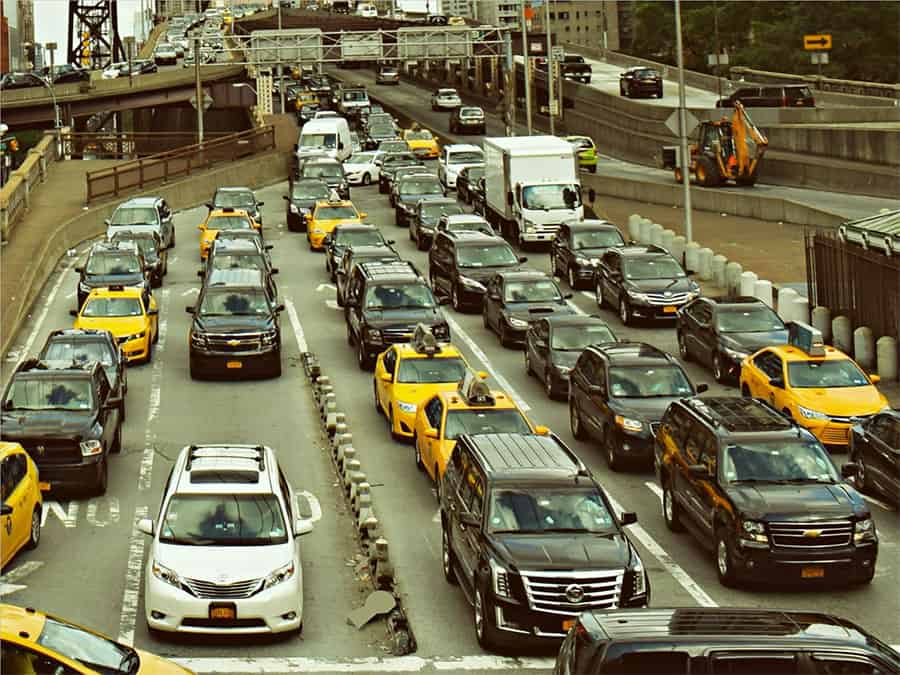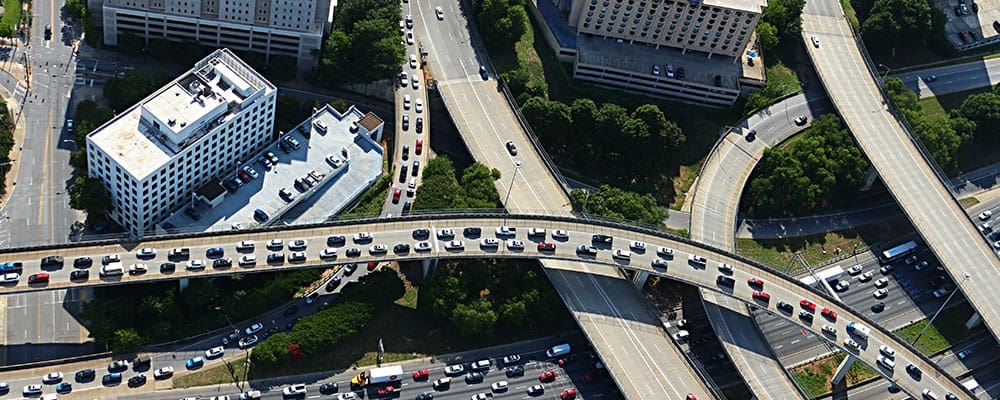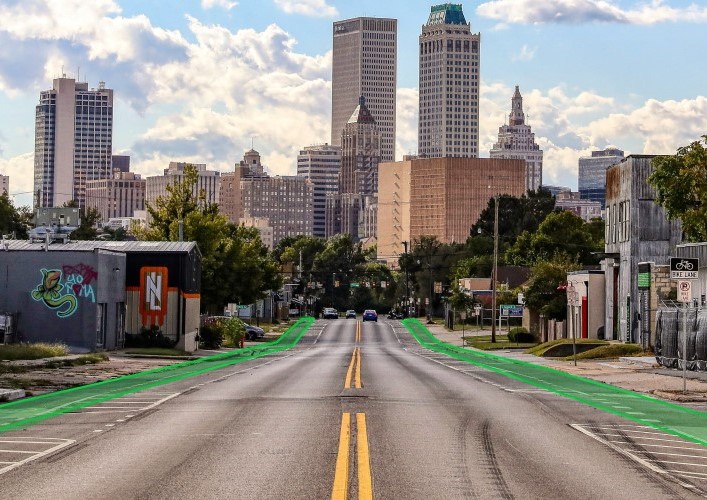
What Is Congestion Pricing, and Is It Always the Right Choice?

In the nation’s busiest urban areas, transportation planners are faced with the urgent task of finding the best way to solve traffic congestion. According to data from Texas A&M, commuters in America’s largest cities lose 84 hours per year, on average, to congestion. In sprawling cities like Los Angeles and Washington, D.C., the problem is particularly egregious, with drivers losing more than two hours per day to slow-moving traffic.1
In the past, planners would have turned to the obvious but unreliable solution of expanding highways and adding lanes to address this problem. However, as that approach has often been shown to make congestion worse, planners are now expanding their array of potential solutions. Chief among them, in many cases, is congestion pricing.
This method of addressing traffic congestion pushes more of the cost of maintaining the busiest roadways onto those who use them. Ultimately, it aims to reduce traffic and speed up the commute for those who lack other options. Congestion charges can be an effective way to reduce congestion and support other transportation and public health goals, but it’s worth analyzing other solutions to determine the best route for your city and to make sure you can make a compelling case for any pricing strategy.
In this article, we’ll explore the following:
- The critical issue of traffic congestion
- What is congestion pricing?
- Perks and drawbacks of a price-based approach
- Other options to consider
- How to know if congestion pricing is right for your city
The Critical Issue of Traffic Congestion
For many U.S. drivers, unmitigated traffic congestion may just seem like an irritating fact of life. However, its economic implications are far more serious, and its environmental consequences much more dire than a mere daily nuisance.
In cities with some of the worst congestion, the daily lurch of traffic amounts to billions of dollars in annual losses. From the expense of wasted fuel to the cost of increased accidents, congestion takes a severe economic toll. In high-traffic cities like Chicago, Los Angeles, and New York, these costs range from $7.6 billion to $11 billion every year.2
The price may be even greater when it comes to pollution and its adverse health effects. For instance, research has shown a direct correlation between traffic volume and the concentration of nitrogen oxides and other pollutants. Regular exposure to these high concentrations during daily rush hour traffic has been associated with increased risks of health problems and even death.3
The rise in pollution in conjunction with congestion isn’t merely a function of a higher number of cars. Studies have shown that slower-moving, stop-and-go vehicles produce higher levels of pollutants, exacerbating poor air quality for those who sit in traffic every day or who live and work near congested highways — people who are often members of already disadvantaged communities.4
Such immediate costs and public health concerns make traffic congestion a top concern for transport planners in America’s most populated areas.
What Is Congestion Pricing?
Congestion pricing is an increasingly popular way to address traffic problems in busy areas. This approach can take various forms, but they all work in basically the same way — they charge drivers to use busy roadways. This is designed to encourage drivers to carpool or consider alternate routes or methods of transportation.
These tollways may operate at all times or only during certain high-traffic periods. They may apply to all drivers on a specific route or, for instance, only to those using high-occupancy vehicle (HOV) lanes without meeting the occupancy requirements. Others may apply road pricing to those who use express lanes to bypass busy corridors. Whatever the specifics, the idea is to apply a “congestion tax” to those who contribute to the clogging, rather than levying a road or fuel tax against all drivers in a given region.5
Perks and Drawbacks of a Price-Based Approach
Are congestion fees the best way to address the problem? That depends on several factors, which we’ll detail below.
Proven Benefits
In the right context, congestion charges bring several important benefits, from reducing traffic to supporting broader transportation initiatives.
Congestion Fees Are Effective at Reducing Traffic
In many cities that have implemented congestion pricing, the effect on traffic volume has been dramatic. In Orange County, California, the tactic doubled vehicle throughput while increasing speed in free lanes three- to fourfold.5 When London instituted road pricing two decades ago, it reduced congestion by 30%.6 Stockholm, which introduced its congestion tax a few years after London, saw a net drop in traffic of 20%.7
But achieving these outcomes requires a detailed analysis to ensure it will be implemented effectively.
Road Pricing Has Health Benefits
As expected, these drops in traffic are accompanied by reductions in pollution. During the first year of London’s congestion pricing program, the city saw nitrogen oxide emissions drop by 13.5% and particulate matter in the air diminish by 15.5%. Research estimates this has added nearly 1,900 years to the lives of London residents over the course of the program. In Stockholm, meanwhile, hospital visits for childhood asthma have dropped by nearly 50%.8
It Supports Other Transportation Goals
Congestion pricing can also be introduced in conjunction with other forms of traffic engineering to support a comprehensive strategy for reducing traffic in overloaded areas. London’s system shifted 10% of commuters toward walking, cycling, or relying on public transportation. In the city center, bus travel increased by a third.6
Cities can use the revenue generated by congestion fees to directly support other transportation initiatives, whether that involves renovating bus stops, adding bike lanes, or supporting forms of micromobility. While congestion pricing programs do bring their own expenses, even a small boost in revenue from these programs can be beneficial for cash-strapped planning departments. Again, it’s essential to delve into traffic data and project the impact of any changes before implementing any specific program.
Criticisms and Limitations
Despite these benefits, congestion pricing garners its fair share of criticism, most of which falls into one of three categories.
The Model Is Unfair
Many critics have raised legitimate concerns over where congestion pricing can be implemented equitably. After all, drivers with lower incomes will find the tolls more difficult to manage than those with more resources.
However, it’s important to note that many models are structured to address these potential inequities. San Francisco’s proposed pricing model, for example, would offer a sliding scale for congestion charges based on income level or disabilities. Likewise, the proposal offers to put some of the revenue from fees toward boosting transit service to underserved locations and even offering free transit to low-income riders. 9
Congestion Pricing Is Unconstitutional
In some cases, opponents of this type of traffic engineering have gone so far as to question its legality. New York City’s Metropolitan Transportation Authority is now facing a lawsuit from New Jersey claiming that its current plan for congestion pricing violates the U.S. Constitution, which doesn’t allow states to enact laws that may place undue burdens on interstate commerce.10 It’s not clear whether the suit will stand up in court, but it’s safe to say there is precedent for states enacting tollways, even where it affects out-of-state residents.
Other Options to Consider
Where there are significant barriers to successful implementation, it’s worth exploring alternatives that can be deployed in conjunction with (or as an alternative to) congestion pricing.
Road Diets
Road diets take a counterintuitive approach to solving congestion issues, but they can be quite effective. Instead of adding lanes, this method seeks to remove or repurpose existing lanes to slow down traffic, reduce demand, and increase safety.
For instance, Santa Monica, California, was able to reduce crashes by 65% in one corridor simply by converting a four-lane road into three lanes with a shared left-turn lane and outer bike lanes.11
Adjusting Traffic Flow
Planners can also look for ways to modify the existing flow of traffic in busy corridors. For instance, this might involve rerouting trucks to free up space or making more proactive plans for when and where roadwork is done. Signal timing adjustments can be particularly helpful in this regard.
However, as city planners found in Temecula, California, this often requires extensive data on turning movement counts (TMC) for various intersections. Fortunately, that’s no problem with the right tools on hand.
Multimodal Transportation
Finally, planners should also consider how they can facilitate more diverse forms of transportation. This is especially necessary if they implement congestion pricing, as it’s critical to have alternative modes of transport for people to choose if the tolls are cost prohibitive.
A multimodal transportation approach expands these options by adding more public transit, bike lanes, pedestrian routes, micromobility, and more. In the same vein, Complete Streets policies can help ensure accessibility for non-motorists, and counteract the equity concerns that are often raised by congestion pricing.
How to Know if Congestion Pricing Is Right for Your City
As with any approach to solving congestion problems in your city or region, there is no definitive solution. Before implementing congestion pricing, it’s essential to conduct a deep analysis of traffic data in congested areas so you can project how any proposed adjustments might affect the flow of traffic.
StreetLight InSight® makes such a deep analysis possible by providing traffic data from virtually every angle. In Napa Valley, data on commute origins helped planners realize that focusing on public transportation could significantly reduce congestion. In Temecula, TMC metrics facilitated a revamp of signal timing. In Atlanta, data on driver demographics and rush hour volume is shedding light on whether congestion fees will improve traffic flow.
To learn how you can use data to determine the right congestion solutions for your city, download Everything But Highway Expansion: Better Data for Faster Congestion Mitigation.
Or, watch how quickly you can analyze local congestion with StreetLight’s Congestion Management solutions in the 3-minute demo below.
1. Texas A&M Transportation Institute. “2021 Urban Mobility Report.” https://static.tti.tamu.edu/tti.tamu.edu/documents/mobility-report-2021.pdf
2. Forbes. “Traffic Congestion Costs U.S. Cities Billions Of Dollars Every Year [Infographic].” https://www.forbes.com/sites/niallmccarthy/2020/03/10/traffic-congestion-costs-us-cities-billions-of-dollars-every-year-infographic/?sh=3af966ea4ff8
3. National Library of Medicine. “Air pollution and health risks due to vehicle traffic.” https://www.ncbi.nlm.nih.gov/pmc/articles/PMC4243514/
4. Research Journal of Chemistry and Environment. “Urban traffic congestion: its causes-consequences-mitigation.” https://www.researchgate.net/publication/367208770_Urban_traffic_congestion_its_causes-consequences-mitigation
5. U.S. Federal Highway Administration. “What Is Congestion Pricing?” https://ops.fhwa.dot.gov/congestionpricing/cp_what_is.htm
6. Transport for London. “Congestion Charge marks 20 years of keeping London moving sustainably.” https://tfl.gov.uk/info-for/media/press-releases/2023/february/congestion-charge-marks-20-years-of-keeping-london-moving-sustainably
7. University of Illinois at Urbana-Champaign. “Downtown congestion pricing in practice.” https://www.researchgate.net/publication/331152719_Downtown_congestion_pricing_in_practice
8. Natural Resources Defense Council. “What is congestion pricing?” https://www.nrdc.org/stories/what-is-congestion-pricing
9. San Francisco County Transportation Authority. “Downtown Congestion Pricing.” https://www.sfcta.org/downtown
10. Bloomberg. “NY Congestion Pricing Plan Violates US Constitution, NJ Governor Says.” https://www.bloomberg.com/news/articles/2024-01-16/ny-congestion-pricing-plan-violates-us-constitution-murphy-says
11. Federal Highway Administration, Road Diet Case Studies. “Santa Monica, California – Ocean Park Boulevard: Road Diet Improves Safety Near School.” https://highways.dot.gov/safety/other/road-diets/road-diet-case-studies/santa-monica-california-ocean-park-boulevard



